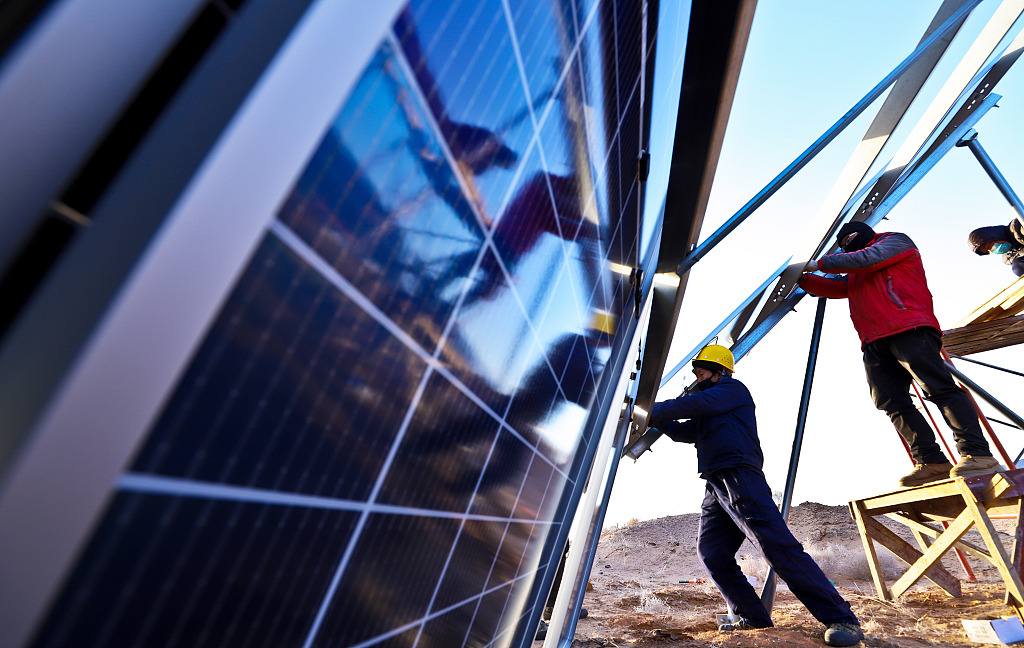China is expected to double its wind and solar capacity by 2025, and achieve the goal of producing 1,200 gigawatts (GW) of solar and wind energy generation by 2030, five years ahead of schedule, a new report has found. Such an outstanding fact prompts reflections on the main trends in the development of the Chinese electric power industry.
Simple calculations showed that even with the annual commissioning of 570 GW of wind and solar power capacities achieved in the previous Five-Year Plan period (2016-2020), China will reach 1200 GW of capacity in 2026, four years earlier than planned. An idea of the scale of new capacity additions can be seen by comparing the total installed wind and solar capacity in the top six countries following China, which was 537 GW in 2020.

Tourists watch the sunrise at the main peak of Baguanao Scenic Area in Shicheng County, Ganzhou City, eastern China’s Jiangxi Province, August 30, 2022. /CFP
According to the National Development and Reform Commission, a new model based on large-scale “clean energy bases” will be applied to accelerate the commissioning of fresh wind and solar capacities. By 2025, these bases, located in deserts and other barren lands, will host about half of the new wind and solar power plants.
Such bases will be spread over huge areas, and each cluster will be a gigawatt-scale project connected to consumers by powerful transmission lines. The concept grew out of similar “coal bases” developed in 2011-2015 and 2016-2020, many of which are in the same less-developed northwestern provinces. These areas will also house the “support” coal-fired power plants to stabilize and support the electricity supply.
The main idea of coal and clean energy bases is to use the enormous land resources of the sparsely populated northwestern provinces to meet the energy needs of the more industrialized southeastern regions. China has 2.6 million square kilometers of desert land, almost the size of Kazakhstan.
Both now and in the future, the vast deserts of Inner Mongolia Autonomous Region and Gansu Province are the most significant bases for renewable energy. By 2025, these regions plan to add about 190 GW to the existing 74 GW of wind and solar capacity. The accelerated development of wind and solar energy will allow them to maintain their role as massive energy suppliers, even with reduced coal production and electricity generation from coal-fired power plants. For example, Inner Mongolia is now China’s second-largest coal producer and largest producer of coal-fired electricity, with per capita carbon dioxide emissions twice the U.S. average.
Workers install photovoltaic panels at a construction site in the Gobi Desert in Zhangye City, northwest China’s Gansu Province, December 7, 2022. /CFP
Electricity in China is still produced mainly by burning coal. Although the share of electricity generated by coal-fired power plants will continue declining, they will now acquire a new function. They will no longer be the “pillars” of the national energy system but will start to play a “stabilizing” or “supporting” role.
It means that coal-fired power plants will operate more flexibly, increasing or decreasing their generation as demand changes and wind and solar energy supply fluctuates depending on the time of day or the weather. In Inner Mongolia and Gansu, an additional 28 GW of coal-fired power plants will be installed to fulfill this “supporting” role. In addition, 16 GW of existing coal-fired power plants will be repurposed as “support” sources for the baseload green energy.
The designation of coal power as an auxiliary energy source also means that new coal power plants and the conversion of existing ones will be built only when necessary to stabilize the energy supply and integrate wind and solar energy into the national energy system.
The total amount of electricity produced from renewable sources between 2020 and 2025 is expected to be about 1,500 terawatt-hours. This volume will cover an average growth in electricity demand of four percent without increasing fossil energy production. It is planned that about 70 percent of the increase will come from wind and solar energy and the rest from nuclear, hydropower and biomass.
Electricity demand rose sharply in late 2020 and early 2021, up 16.5 percent in the first six months of 2021. The dynamics of further growth will depend on the situation in the global economy and national economic policy priorities. But the fast development of hydrogen energy, the electrification of transport, and home cooling and heating will accelerate the growth in demand for electricity. The country will need massive amounts of carbon-neutral energy to meet new electricity needs.
No one can dispute that China has achieved leadership in green technologies. The country’s recent progress has cemented this status, but new achievements will be even more impressive.
Djoomart Otorbaev, a special commentator on current affairs for CGTN, is the former prime minister of the Kyrgyz Republic, a distinguished professor of the Belt and Road School of Beijing Normal University, and the author of the book “Central Asia’s Economic Rebirth in the Shadow of the New Great Game”(Routledge, 2023). The article reflects the author’s views and not necessarily those of CGTN.



